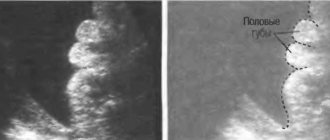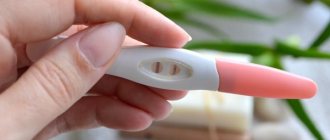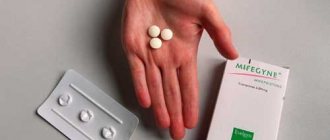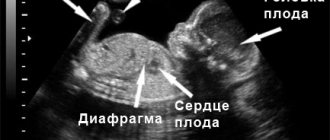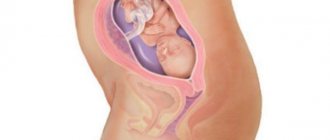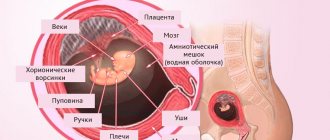Appearance time
From the first days of pregnancy, women's breasts begin to prepare for lactation, and certain changes occur in the hormonal background. This leads to the fact that from the moment the baby is conceived, the production of colostrum begins.
- Almost always, a woman in the first trimester (up to 12 weeks) does not feel or notice this, because the amount of this nutrient fluid is minimal. However, there are cases when the appearance of colostrum is the first sign of a woman’s pregnancy. It depends on the individual characteristics of the organism.
- In the second trimester (from 13 to 28-30 weeks), colostrum production begins more actively, and many women notice yellowish sticky droplets on their clothes. These discharges may not be daily, appear regardless of the time of day and have different amounts (from 1 drop to 1-2-5 ml).
- The third trimester (from 30-31 weeks until birth) in most women is accompanied by the release of colostrum in varying amounts. It acquires a less saturated color, but its amount does not change significantly.
Breast discharge during pregnancy is associated with several environmental factors:
- emotional situations (both stress and positive moments);
- taking a hot shower;
- after prolonged sexual intercourse;
- after massage of the mammary glands;
- hot drink (water, tea or other drinks).
information After birth, colostrum becomes even more transparent, but still retains its yellow color and chemical composition.
It is secreted for the first 3-7 days, after which it is replaced by mature white milk with a slightly different composition.
Colostrum in non-pregnant women
Colostrum can be produced not only during pregnancy and lactation, but also after the period of feeding the baby for 1-2 years. The sudden appearance of colostrum, not associated with pregnancy and recent feeding of the child, may mean that the content of hormones - oxytocin and prolactin - has increased in the woman’s body.
- hormonal imbalance in the body;
- mastitis (in this case pus is released);
- fibroadenoma and other tumors.
Properties of colostrum
The yellow secretion of the mammary glands performs a number of functions:
- Saturation of the child’s body with immune cells (proteins). The baby’s immune system begins to work from 6 months after birth, therefore, starting from the oral cavity, the necessary cells are detached from the colostrum, which are involved in protecting the child from pathological microorganisms coming from the environment.
- Colonization of the intestines with beneficial microflora (bifidobacteria and lactobacilli). It promotes the absorption of milk and other products that the child will receive, normalizes the baby’s bowel movements, and prevents the proliferation of pathological microorganisms.
- Accelerating the excretion of meconium (original feces that fills the entire intestine of a newborn baby) and preparing the intestines for the arrival of the first portions of milk.
- Binding of excess bilirubin from the baby’s blood and intestines, which prevents the development of jaundice.
- Enriching the child with essential vitamins and minerals, which are essential from the first days of life for the physiological development and growth of tissues and organs.
- Saturation of the baby's blood with antioxidants, which help adapt to a new environment, especially in the respiratory system.
- Acceleration of the maturation of the intestinal epithelium due to growth factors (cortisol, insulin, insulin-like growth factor - IGF, epidermal growth factor - EGF).
important Colostrum is extremely nutritious and is extremely necessary for a child in the first days of life.
During its production during pregnancy, it accumulates many nutrients and has an ideal composition, starting from the first breastfeeding in the delivery room.
A few secrets about the secretion of the mammary glands
A sticky, sweetish, viscous, translucent or yellowish liquid is the first nutrient fluid of your mammary glands, or colostrum. The closer to childbirth, the lighter the secretion of the mammary glands becomes. The basis of colostrum is albumin (one of the most important proteins). It helps the child grow and adapt to the harsh realities of our world.
When excreting colostrum, the following are unacceptable:
- painful sensations;
- discharge from one nipple;
- a change in the color of the secretion (from white or slightly creamy to yellow-green, brown) and the appearance of streaks of blood.
If you notice something like this, hurry to the doctor and do not neglect additional examinations (ultrasound).
Stimulates the production and secretion of 2 hormones:
- prolactin;
- oxytocin.
In addition to releasing a few drops of secretion from the nipple, these hormones promote the growth of mammary gland tissue, increasing the sensitivity of the SAC area (nipple and areola), dilation of the mammary gland ducts and the activity of the lobules that make up the mammary gland.
Norm and deviations
Despite the fact that colostrum is actively produced from the first stages of pregnancy, not every woman can observe its release. This is no cause for concern. It is quite possible that the lobules and ducts of the mammary gland have a fairly dense network and these drops of yellow liquid do not require release, or that there are few provoking factors and they are quite rare. The absence of colostrum during pregnancy in some women is considered a physiological norm , as is its appearance in the early stages of pregnancy.
Small or rare release of colostrum, its absence, or, conversely, a large amount of it, does not indicate the amount of milk after the birth of the baby. These are two different processes with different influencing factors and even hormonal levels.
Quite rare, but it is possible that a minimal amount of blood inclusions may appear in colostrum during pregnancy. In the absence of any other symptoms, this is also within the normal range. The ducts gradually expand, the mammary gland is rebuilt, and this can periodically lead to the rupture of small capillaries and the release of blood.
Between the second and third trimester, a woman may feel itching in the mammary glands and slight bloating, pressure from the inside. This indicates an even greater opening of the ducts, the movement of colostrum through the ducts and the active preparation of the breast for lactation. In this situation, also in the absence of other symptoms, there is no reason to sound the alarm and consult a doctor.
dangerous However, there are also variants of pathological conditions when the help of a medical professional may be required.
Breast discharge accompanied by pain
This may indicate the development of an inflammatory process in the mammary glands. To avoid purulent mastitis and contamination of milk when feeding your baby, you should promptly seek help from your local obstetrician-gynecologist and undergo a course of anti-inflammatory therapy.
If the release of colostrum is accompanied by nagging or cramping pain in the lower abdomen or in the sacrum and lumbar region, this indicates increased tone of the uterus and there is a risk of premature birth. This is due to an excess of oxytocin (a hormone that is actively involved in labor and prevents the development of postpartum hemorrhage). In this case, hormone replacement therapy is necessary. The doctor selects the drug and its dosage depending on the woman’s oxytocin levels.
Colostrum with blood
If the bleeding is quite profuse and is accompanied by pain in the mammary glands, uterus, or poor health in a pregnant woman, then you should immediately consult a doctor. This condition can be caused by the development of inflammatory processes, the risk of premature birth, or the growth of a neoplasm (both benign and malignant). The doctor will order a mammogram, magnetic resonance imaging and laboratory testing of blood and colostrum.
Foul odor of colostrum
Colostrum acquires the smell due to the active development and reproduction of a bacterial infection in the mammary glands. This may be accompanied by pain, fever, general weakness, or be asymptomatic. To treat this condition, it will be necessary to undergo a course of antibiotic therapy, with the most gentle effect on the baby. If you do not take appropriate medications, there is a high risk of fetal infection. And if there are several days left between the moment of infection of the mammary gland and birth, the child may be infected through breast milk during feeding.
Colostrum in the absence of pregnancy
It is quite a rare occurrence when there is no pregnancy, but colostrum is released from the mammary glands. This may be due to increased levels of oxytocin or prolactin, the development of an inflammatory or tumor process.
important If this condition occurs, you should immediately contact a gynecologist to avoid serious consequences of the disease.
Rules of hygiene and breast care
There are generally accepted hygiene rules for pregnant women who leak colostrum. Let's list them:
- During the period of wakefulness, wash in the shower twice, in hot periods - more often.
- Avoid hard soaps, since their ingredients dry out the skin, and use intimate hygiene gel because it has a low pH and components that gently cleanse the mucous membranes and skin.
- Use a soft terry towel, dry with blotting movements and do not rub your breasts under any circumstances, as this stimulates milk production.
It is recommended to use special bras for expectant or nursing mothers and correctly determine its size. If a woman leaks colostrum, it is necessary to purchase special breast pads, which must be changed at least 3 times a day.
It is important to remember that colostrum should not be squeezed out during pregnancy to avoid the risk of premature birth. Special exercises and a contrast shower will help prevent sagging breasts and the appearance of stretch marks. It is advisable to use vegetable oils for breast skin care. By paying close attention to her health, the expectant mother can avoid and prevent possible complications that threaten the life and health of the unborn child.
What to do if you have colostrum leakage
There are no hard-to-follow rules for the production and excretion of colostrum. Caring for the mammary glands is quite simple:
- Wearing a specialized bra for pregnant and lactating women (made of natural fabrics, soft material, appropriate size, not pinching the breasts).
- Washing the mammary glands with clean warm water 1-2 times a day, without using soap (to prevent cracks, inflammation and colonization of microorganisms).
- Using a soft towel to wipe or blot the mammary glands (without sudden or rough movements, avoiding pain and chafing).
- Apply specialized pads between the underwear and nipples (you can use regular cotton pads, gauze, handkerchiefs). Change them regularly to avoid the development of infection.
- Do not massage the mammary glands (this will speed up lactation and increase uterine tone).
- Do not express colostrum (this will speed up lactation and increase uterine tone).
- Use moisturizing creams (this will prevent stretch marks on the breasts and reduce the risk of cracked nipples, both during pregnancy and lactation).
- Follow the rules of a balanced diet (reduce carbohydrate intake - flour products made from refined wheat flour, sugar, potatoes and white rice, consume large amounts of animal and plant proteins, fruits and vegetables, and increase fat intake 1 month before giving birth).
dangerous In case of pathological impurities, pain, poor health, uneven enlargement of the mammary glands, you should immediately contact your local gynecologist in charge of the pregnancy.
In this case, it is recommended to undergo a full examination and the necessary treatment to avoid complications and infections of the baby and mother.
Things to consider
During pregnancy, a woman must adhere to established rules and recommendations.
Yellow secretion is no exception. In this regard, the expectant mother should follow
following recommendations:
- Maintain personal hygiene. This is especially true during the period of colostrum release. This rule is one of the main conditions for the birth of a healthy baby.
- Choose a suitable bra.
It should not squeeze your chest. It is best to pay attention to special models for nursing mothers. They will be needed not only during pregnancy, but also after the birth of the baby. - Use special inserts. Today in the pharmacy you can find devices that allow you to deal with copious secretions. An alternative option would be cotton pads
. Special inserts are inserted into the bra. At the same time, you should not forget to change your underwear and accessories in a timely manner, since a humid environment creates optimal conditions for the proliferation of harmful bacteria. Inserts are the optimal solution to the problem when colostrum appears before birth. - Periodic water procedures. Throughout the day, the expectant mother should rinse her breasts several times with warm water. There is no need to use soap. Such procedures will prevent the occurrence and development of infections.
- Do not express
colostrum. Performing such manipulations will lead to an increase in its production. - It is not recommended to stimulate the breasts intensively. Performing such actions leads to the release of oxytocin into the blood. It provokes frequent contractions of the uterus. As a result, this can end very badly.
- Many women are interested in why colostrum should not be squeezed out? During breast stimulation, infection can occur
.
Following these rules and recommendations during the release of colostrum will avoid many problems that can negatively affect the health of the mother and child. Particular attention should be paid to your feelings. After all, during pregnancy, disruptions in the functioning of the body are possible, which entails serious consequences. Therefore, you need to know how long the secret is released. Useful video: the appearance of colostrum
What does colostrum look like normally?
Colostrum is a viscous liquid with a sweet taste. The color can vary from almost transparent to yellow. As birth approaches, the color becomes lighter. The basis is protein – albumin, which is necessary for the baby’s adaptation to changing conditions. The composition also includes water, vitamins, minerals, hormones, bifidobacteria and lactobacilli, fats, sugars, food enzymes, and antioxidants.
If a pregnant woman finds small yellowish spots on her bra, there is no need to worry: such traces are left by biological fluid, the phenomenon is considered physiological.
So, we have already found out that the release of a small volume of colostrum already in the first weeks of pregnancy is the norm. However, if colostrum does not appear in you until after birth, this is also normal!
Minor impurities of blood in colostrum may appear due to capillary ruptures during the expansion of the mammary gland ducts. If nothing bothers you other than the “visual effect,” then this is also a variant of the norm.
The vast majority of pregnant women experience a feeling of itching, swelling, and fullness of the breasts in the second and third trimester. In this way, the mammary glands are rebuilt to produce milk.
Causes of colostrum during pregnancy
A woman's hormonal background changes during pregnancy. The amount of prolactin, a lactation-stimulating hormone, increases. It is necessary for changes in the mammary glands that precede the start of breastfeeding.
A number of factors can stimulate the appearance of discharge. Fluid is often observed during strong sexual arousal, during sexual intercourse, or orgasm. Stimulation of the breasts and nipples promotes its appearance. It may occur after taking a hot shower or bath, sauna, bath, or with an increase in body temperature. In addition, discharge can be provoked by wearing too tight underwear, intense positive emotions, and infectious pathologies.
Affects lactation and nutrition of the expectant mother. If a woman fasts during pregnancy and adheres to strict diets, there will be no more discharge. A balanced menu, on the contrary, promotes more intensive work of the mammary glands. Consuming hot drinks and dishes, a large amount of hot spices can also have an effect: the ducts dilate, the fluid leaves the gland more easily.
When will the first milk appear?
Milk begins to be produced after birth. You should not expect it to appear during pregnancy. A woman who has recently given birth also does not produce milk immediately after the baby is born. Since the first few days the baby’s body is not yet ready to digest new food, only colostrum is released, preparing the stomach and intestines for the changed type of nutrition.
There is no need to worry that the child is hungry; give him artificial formula in the first days. Birth involves a sharp change in living conditions: the baby has to breathe on his own; instead of a liquid environment, he is now surrounded by an air environment, where sudden changes in temperature, loud sounds, and too bright light are possible. This situation is stressful; the newborn no longer needs the breast for food, but for calm and relaxation.
How do you prepare for lactation?
In a pregnant woman's body, preparation for breastfeeding begins from the moment of pregnancy, and the first discharge from the mammary glands may appear in the very early stages. There are no uniform norms and rules in this process - colostrum is produced by the body regardless of whether it flows out or not. Indirect evidence of colostrum production are symptoms:
- feeling of soreness in the glands;
- increasing their volume;
- increased sensitivity and feeling of fullness;
- tingling and itching in the glands.
Representing secretions of varying intensity in the form of a viscous liquid, colostrum can be either translucent white or intense yellow. As labor approaches, it becomes lighter and more transparent. In the early stages, the reasons for such discharge are:
- stressful conditions;
- gland stimulation;
- long exposure to the sun or heat;
- hot shower.
In the first trimester, colostrum production is observed infrequently, but it is also possible that its appearance may serve as a sign of pregnancy. In some cases, discharge that appears during this period disappears later. If you experience discharge from the breast at the very beginning of pregnancy, it is better to consult a gynecologist and mammologist.
- During the second trimester, starting from 14-15 weeks, colostrum is produced more actively: the volume of discharge can reach 3-4 ml. This is a completely natural process associated with the maturation of the placenta and the hormone prolactin produced by the pituitary gland.
- In the third trimester, colostrum has a less intense color, and the volume of discharge varies individually.
- After the birth of the baby, it is produced for several more days, becoming less and less saturated, without losing its properties. Then the colostrum is replaced with milk, which has a slightly different composition.
